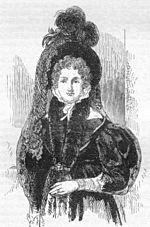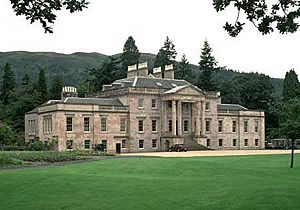Janet Colquhoun facts for kids
Quick facts for kids
Janet Colquhoun
|
|
|---|---|

Portrait from her biography
|
|
| Born | 17 April 1781 London, England |
| Died | 21 October 1846 (aged 65) Helensburgh, Scotland |
| Nationality | British |
| Subject | Religion |
| Spouse | Sir James Colquhoun, 3rd Bt |
Janet Colquhoun (pronounced kə-HOON; born Sinclair; also known as Lady Colquhoun of Luss; 17 April 1781 – 21 October 1846) was a British writer who focused on religious topics. She was also a kind person who helped many good causes. She believed that showing your faith meant doing good deeds for others.
Janet's Early Life
Janet Sinclair was born in London in 1781. She was the second daughter of Sir John Sinclair, a member of Parliament, and his wife Sarah. After her mother passed away, Janet and her sister were raised by their grandmother at Thurso Castle. Janet became a strong Christian after being inspired by William Wilberforce, who worked to end slavery.
In 1799, Janet married Sir James Colquhoun of Luss, a Scottish military officer. She was very happy when he became a leader in the Scottish church in 1816. Janet found it difficult to be part of the wealthy upper class. She didn't like the way people in her social group sometimes judged others.
Helping Others: A Philanthropist
Janet Colquhoun was a true philanthropist, meaning she loved to help people. She started a small school in her home. There, young girls could learn important skills like cooking and sewing. The students really valued Janet's lessons. This was different from her earlier attempts to read the Bible to her own staff, which hadn't gone as well.
Janet and James Colquhoun had five children. They lived in a house in Charlotte Square in Edinburgh. Their two sons studied in Edinburgh and Lincolnshire before going to Edinburgh University. Their youngest son, John Colquhoun, joined the army and later became a famous sports writer.
Janet continued to support many good causes. Her strong religious beliefs led her to give up reading novels and going to the theatre in the early 1800s. It's said that in 1811, when she turned 30, she was happy to leave her youth behind without any regrets.
Janet was involved in many different charities. She published several religious books without putting her name on them. She was the treasurer for the Scottish Gaelic Society. She also helped the local Bible society. She supported the Irish Home Mission and helped provide education in India. Janet's family paid for the local Free Church. It is said that she made the builders remove plans for a special seat just for her family.
Becoming a Writer
After Janet became ill in 1820, she used her energy to write books about religion. Her first book, Despair and Hope, came out in 1822. It explained her religious beliefs through conversations with a dying person. Before she got sick, Janet often visited poor people on her family's estate.
She published her books without her name until her husband passed away in 1836. Janet believed that faith was the most important thing. However, she also believed that good actions would show a person's true faith. In 1842, the first train from Edinburgh to Glasgow was set to run on a Sunday. Janet strongly disagreed with this. Later, when she needed to make the same trip, she avoided the two-hour train journey. Instead, she took two days to travel the same distance by horse.
Janet Colquhoun died in Helensburgh in 1846. A book about her life was put together by Reverend James Hamilton. It used her letters and diary and was published in 1849.
The Scottish writer and artist Lucy Bethia Walford was Janet's granddaughter.
Janet's Books
- Despair and Hope (1822)
- Thoughts on the Religious Profession (1823)
- Impressions of the Heart (1825)
- The Kingdom of God (1836)
- The World's Religion (1839)


